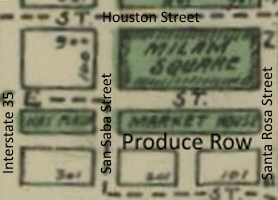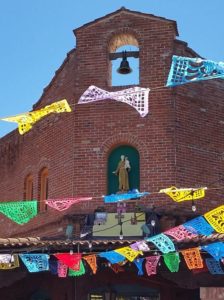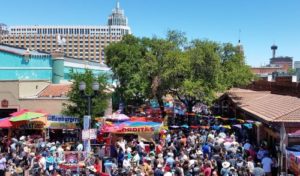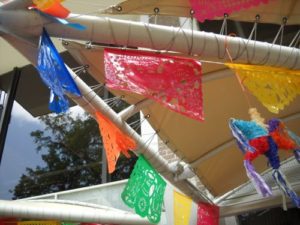I finally made it to exactly one Fiesta event this year, the Fiesta de los Reyes at Market Square. The “Reyes” of the title is, specifically, the Rey Feo (literally “ugly king,” but some of our Reyes Feos have been quite attractive in my opinion). From what I can gather, the man who becomes Rey Feo is the one who raises the most money towards a scholarship program.
The Fiesta de los Reyes came across as a pretty standard street festival. Fortunately, I love street festivals. There were several stages set up (one under Interstate 35, one on San Saba Street, and at least two down Produce Row).
Okay, you’re going to need some kind of a map. I may have zoomed in on this a bit much, but here it is:

Interstate 35, of course, wasn’t there yet in 1909, because the Interstate System wasn’t even authorized by Congress until 1956. The US Numbered Highway system (things like US Route 1, US Route 6, US Route 30, etc.) wasn’t even in place yet in 1909.

The bands that were playing when we were there in the early afternoon were a Mexican group called Dynastia Moreno (unfortunately, I’m not that familiar with Mexican musical styles to be able to identify their style of music. They sounded good, though), a Christian gospel/blues band called, well, Rev. Blues (they’re Texans, but blues bands always make me homesick for Chicago), a cover band of what looked like teenagers that was playing “Enter Sandman” as we walked past, and some other band at the Santa Rosa and Produce Row end of Market Square on a stage on the steps of the old Museo Alameda, which is now the Centro de Artes of Texas A&M – San Antonio. Unfortunately, it was too crowded for me to be able to read the signs giving the names of those groups. I figured I’d be able to look them up later, and I’m having no luck at all with that yet.
The Museo Alameda was an experiment on the part of the people at the Smithsonian. The Museo Alameda was a museum for Latin American art that was a full affiliate of the Smithsonian. It didn’t really catch on, unfortunately, and only five years after it opened, the Museo Alameda closed its doors. San Antonio still has a Smithsonian affiliate, though. Since 2014, the Witte Museum has been a Smithsonian affiliate.
That reminds me, the new upgrades to the Witte are done and Alex and I visited it and took even more pictures. I have to post that soon.

And, as I said before, Market Square was packed with people. It was a lovely day in the mid- to high 70s, so Alex and I had more energy than we do during the summer months, but it was even a little crowded for me, and I generally love the hustle and bustle of public festivals. So we walked once around and got a little of the fiesta spirit, took some pictures, and then went home. The “walk once around,” by the way? Took an hour and a half.

